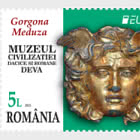Under the issue Europa 2014, Romfilatelia introduces into circulation the postage stamps issue National Music Instruments, consisting of 2 stamps.
The designer conceived this topic as an artistic illustration shaped around the main idea of the intertwining between religion and secularism.
The issue illustrates images of musical instruments that can be found in the iconography of Orthodox churches in Moldavia, as well as pictures of traditional music instruments such as: the lute, the cobza, the fiddle, the flute, the tulnic.
On the postage stamp with the face value of lei 2.10 is illustrated the “tulnic”, an old music instrument specific to The Stone Land (Tara Motilor). Considered an integral part of the Romanian people’s cultural legacy, the “tulnic” is depicted in the hands of an angel, a symbol of sacredness, and also in the hands of a child from the mountains, a gentle keeper of ancestral customs and traditions. The instrument is tubular shaped, open at both ends, similar to the alphorn and having a slight curvature at one end, which produces sounds by blowing air into it; it is produced from the tree bark of the Linden Tree or Willow, and is used for long distance signaling and communication.
The lute is the musical instrument depicted on the postage stamp with the face value of lei 14.50. This is a plucked strings folk instrument alike the cobza. It is almond shaped, slightly flattened, having a curved back, a neck without bars, and a face resonance orifice on its face; the head is tilted backwards. With Persian-Arabic roots, the lute knew a flourishing period and became very popular during the Renaissance and Baroque periods, when it was one of the most common and widely used music instruments. Its popularity was also due to the fact that most of the music scores were using tabs (alphabetical or numerical notation), which were also accessible to those who didn’t know the musical notation. Music is suggested by a group of folk musicians, colorful characters of former outskirts and markets, where performers play the violin, lute and flute.
The two stamps are joined by a first day cover, which shows two instruments paradoxically alike: the church organ, thus suggesting the religious character, and the flute, a miniature organ, an instrument deeply cherished by Romanians due to its internalized and ethereal sound, known within the Romanian ethnic-cultural space since Antiquity, and being an integral part of the Dacians’ existential universe.














































